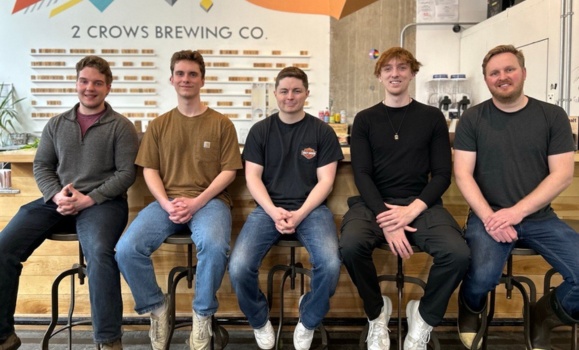Halifax's has been on a mission to decrease its carbon footprint since opening its doors in 2017. As part of that commitment, the beer maker now sources 95 per cent of its ingredients locally.Ěý
“But once we use those ingredients, we are just creating more CO2 and that kind of negates the positives of buying local,” explains Jeremy Taylor, owner and brewer of the company.
"During the fermentation process, the majority of breweries just let the CO2 that’s produced as a by-product of fermentation up into the atmosphere, and it’s kind of a waste,” he adds.
Taylor is now taking his sustainability efforts one step further with a unique Dalhousie Engineering Capstone project that involves using micro-algae as a means of carbon-capture. Taylor partnered with four chemical engineering students from Dalhousie’s Department of Process Engineering and Applied Science to help with the process.
All senior-year undergraduate engineering students take part in a Capstone project, which provides an opportunity to collaborate with industry on real-world challenges.
Ěý“As a small company, we don’t have the resources to hire an engineering firm to play around with something that hasn’t really been done before,” explains Taylor, emphasizing the added importance of partnering with Dalhousie’s Capstone project and contributing to student education.
Exploring possibilities
Craig Everett, one of the chemical engineering students participating on the project, says it’s been an “eye-opening experience” that has shifted his perspective on how companies can easily innovate to enhance their sustainability endeavours.
The project requires a unique blend of biology and chemistry. "So what we’re looking to do is use a biologically friendly way to capture that carbon and store it, and eventually we’ll use that carbon for some sort of product," explains Everett.
The process entails taking the CO2 produced by the brewery, bubbling it through a medium containing additional CO2, and allowing micro-algae to absorb some of the carbon. "Micro-algae has the ability to sequester CO2. It can use CO2 as its carbon source of growth. They just need light and CO2 and a few little micro-nutrients and then they’re happy as clams. This carbon is then stored and utilized by the algae for growth,” explained Everett and Taylor in an interview.
How will the company use the product in the future? While it can be utilized as animal feed or as human supplements, the end goal has yet to be determined. For now, Everett says the main goal is to reduce the CO2 that 2 Crows Brewery is pumping into the atmosphere.
Recommended reading:ĚýWhere Ideas Meet Impact — Hydrologist's research positions her to take a global lead in atmospheric carbon dioxide removal
Challenges and growth
For Everett and his fellow teammates, the Capstone Project has been a journey of challenges and growth. He says that the intricacies of working with biological systems required extensive research and reaching out to various resources for guidance.Ěý
“At first, it was a bit jarring, a bit overwhelming, but we’ve adapted. Biological systems are a bit finicky; it’s not tight and dry whatsoever.”
The hands-on-experience has not only deepened Everett’s understanding of the subject but also provided him with a tangible sense of accomplishment. “I’ve gained a lot of respect for what it means to have an actual project attached to your name and to be able to call something yours.”
For 2 Crows Brewery, this project hasn’t been just about reducing their carbon footprint. Taylor says it’s a testament to their commitment to sustainability and education.
He adds that partnering with Dalhousie's engineering students not only brought fresh perspectives but also fostered a collaborative spirit.Ěý
"It’s been fantastic. They are a great group of students. They know what they’re doing and they are incredibly thorough. It’s exciting to see their progress and how their whole project comes together.”

